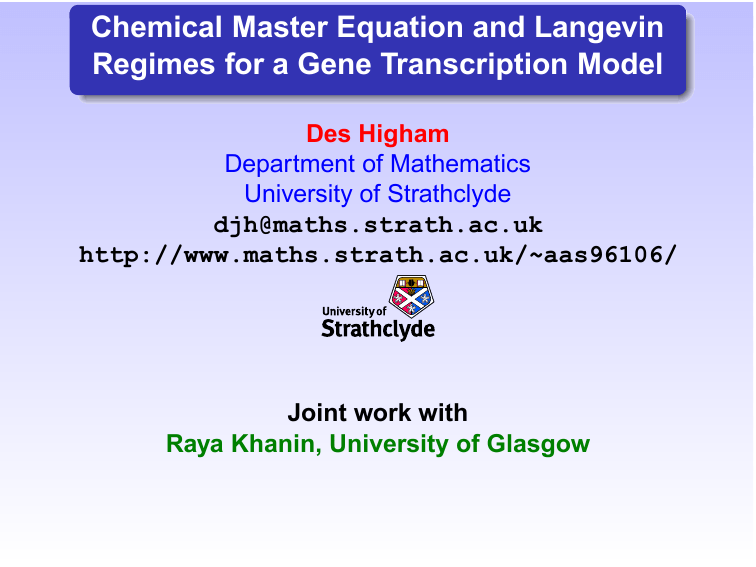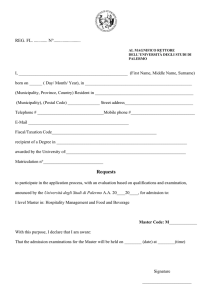Chemical Master Equation and Langevin Regimes for a Gene Transcription Model
advertisement

Chemical Master Equation and Langevin
Regimes for a Gene Transcription Model
Des Higham
Department of Mathematics
University of Strathclyde
djh@maths.strath.ac.uk
http://www.maths.strath.ac.uk/~aas96106/
Joint work with
Raya Khanin, University of Glasgow
Outline
Chemical kinetics
First order reactions
Gene regulation model
Means, variances and correlations
Switching model
NASPDE
Des Higham
Chemical Master versus Langevin
2 / 21
Chemical Kinetics (Gillespie 1976, 2000)
Well-stirred, thermal equilibrium, fixed volume.
Chemical Master Equation (CME)
Species have integer values.
ODE for prob. of every possible state at time t.
Chemical Langevin Equation (CLE)
Species have real values.
SDE for “concentration” of each species at time t.
Reaction Rate Equations (RRE)
Species have real values.
ODE for “concentration” of each species at time t.
NASPDE
Des Higham
Chemical Master versus Langevin
3 / 21
Stoichiometrics
N chemical species, M types of reaction (e.g. A + B → C)
State vector
X1 (t)
X2 (t)
X(t) = .. ,
X(0) = X0
.
XN (t)
Each reaction, 1 ≤ j ≤ M, is described by
a stoichiometric vector ν j ∈ RN such that
X(t) 7→ X(t) + ν j ,
a propensity function aj (X(t)) such that the prob. of this
reaction taking place over time [t, t + dt) is aj (X(t)) dt
NASPDE
Des Higham
Chemical Master versus Langevin
4 / 21
Example: Michaelis–Menten
Four species: substrate, enzyme, complex & product.
Three types of reaction
c
1
S1 + S 2 →
S3
c
2
S3 →
S1 + S2
c
3
S3 →
S4 + S2
So
−1
−1
ν1 =
1 ,
0
1
1
ν2 =
−1 ,
0
0
1
ν3 =
−1 .
1
Propensity functions:
a1 (X(t)) = c1 X1 (t)X2 (t), a2 (X(t)) = c2 X3 (t), a3 (X(t)) = c3 X3 (t)
NASPDE
Des Higham
Chemical Master versus Langevin
5 / 21
CME
Discrete state space, continuous time Markov chain.
Let P(x, t) be the prob. that X(t) = x.
M
dP(x, t) X
=
(aj (x − ν j )P(x − ν j , t) − aj (x)P(x, t))
dt
j=1
Gillespie’s stochastic simulation algorithm gives a way to
compute realisations of (t, X(t)).
Takes account of every reaction ⇒ expensive.
NASPDE
Des Higham
Chemical Master versus Langevin
6 / 21
CLE
SDE in RN .
d Y(t) =
M
X
ν j aj (Y(t))dt +
j=1
M
X
j=1
νj
q
aj (Y(t)) dWj (t)
Euler–Maruyama computes approximate realisations of
(t, Y(t)).
(Switching off the noise gives the RRE.)
NASPDE
Des Higham
Chemical Master versus Langevin
7 / 21
c=1
Example: S → ∅, start with 10 molecules
NASPDE
12
10
8
6
4
2
0
0
0.5
1
CME
Des Higham
1.5
2
CLE
2.5
3
3.5
4
RRE
Chemical Master versus Langevin
8 / 21
c=1
Example: S → ∅, start with 100 molecules
NASPDE
100
90
80
70
60
50
40
30
20
10
0
0
1
CME
Des Higham
2
3
CLE
4
5
RRE
Chemical Master versus Langevin
9 / 21
c
Example: S → ∅, start with N molecules
CME :
d
p (t)
dt i
= c · (i + 1) · pi+1 (t) − c · i · pi (t)
gives E [X(t)] = Ne−ct and Var [X(t)] = Ne−ct 1 − e−ct
CLE : d Y(t) = −cY(t) dt −
p
cY(t) dW (t)
gives E [Y(t)] = Ne−ct and Var [Y(t)] = Ne−ct 1 − e−ct
RRE :
NASPDE
d
z(t)
dt
= −cz(t) gives z(t) = Ne −ct
Des Higham
Chemical Master versus Langevin
10 / 21
First Order Networks: Gadgil et al. 2005
ks
Production From a Source: ∅ →i Si
Stoichiometric vector ν = ei
Propensity function ksi
k d Xi
i
Degradation: Si →
∅
Stoichiometric vector ν = −ei
Propensity function kdi Xi (t)
kcon
Xj
ij
Conversion: Sj → Si
Stoichiometric vector ν = −ej + ei
Propensity function kcon
ij Xj (t)
kcat
Xj
ij
Catalytic Production From a Source: ∅ → Si
Stoichiometric vector ν = ei
Propensity function kcat
ij Xj (t)
NASPDE
Des Higham
Chemical Master versus Langevin
11 / 21
Central Dogma of Cell Biology
NASPDE
Des Higham
Chemical Master versus Langevin
12 / 21
Gene Regulation Model
Raser & O’Shea, Science, 2004:
k
D →a D ?
kb
D←
D?
k
D ? →r D ? + M
kp
M →M +P
γr
M→∅
γp
P→∅
Generalizes Thattai & van Oudenaarden, PNAS, 2001
Noise typically measured as ratio of mean to variance
NASPDE
Des Higham
Chemical Master versus Langevin
13 / 21
First-Order Networks:
Mean, Variance and Correlation
Gadgil et al., Bull. Math. Biol., 2005:
explicit ODEs for E[Xi (t)] and E[Xi (t)Xj (t)],
1 ≤ i, j, ≤ N.
New Result The CLE matches the CME in the sense that
E[Xi (t)] = E[Yi (t)] and E[Xi (t)Xj (t)] = E[Yi (t)Yj (t)].
Proof Ito’s Lemma and a lot of algebra.
Note:
suggests that, for first order networks, CLE is a very
good proxy for CME
result requires existence/uniqueness for CLE, which is
open in general
NASPDE
Des Higham
Chemical Master versus Langevin
14 / 21
Raser & O’Shea model again
k
a
Di →
Di?
k
b
Di ←
Di?
k
Di? →r
Di? + M
and
1≤i ≤m
kp
M →M +P
γr
M→∅
γp
P→∅
Hybrid approach (e.g. Paszek, Bull. Math. Biol., 2007):
treat the Di and Di? as discrete and M and P as continuous.
NASPDE
Des Higham
Chemical Master versus Langevin
15 / 21
Hybrid Model
Let r(t) denote the number of active genes at time t.
Then r(t) takes values in {0, 1, 2, 3, . . . , m} driven by a
continuous time Markov chain.
Using the CLE framework for the remaining reactions we
get a switching SDE:
d
M
P
=
kr r −γr M
kp M −γp P
+
NASPDE
√
dt
√
kr r − γr M 0
0p
p
0
0
kp M − γp P
Des Higham
dW1
dW2
dW3
dW4
Chemical Master versus Langevin
16 / 21
Means, Variances and Correlations
There is a generalized version of Ito’s Lemma for switching
SDEs (Mao and Yuang, 2006).
Using this:
New Result E[r], E[M], E[P], E[Mr], E[Pr], E[MP], E[r2 ],
E[M2 ] and E[P2 ] for the hybrid model match those for the full
CME.
NASPDE
Des Higham
Chemical Master versus Langevin
17 / 21
Summary
What’s new?
For first order networks:
CLE formulation matches means, variances and
correlations of the underlying CME.
This also extends to a hybrid gene regulation model.
What’s Next?
Spatial effects (subdiffusion)
Delays
Cell growth
Existence theory for the SDEs
Analysis for second order reactions
Multiscale simulation algorithms
NASPDE
Des Higham
Chemical Master versus Langevin
18 / 21
Simulation Results for a Dimerization Model
k
ν1 =
1
0
,
1
∅→
P
ka
P + P → P2
γp
P →∅
γp
P2 →2 ∅
−2
−1
ν2 =
, ν3 =
1
0
ν4 =
a1 = ka , a2 = ka P(P − 1)/2, a3 = γP P, a4 = γP2 P2
d
NASPDE
P
P2
0
−1
k1 − ka P(P − 1) − γP P
=
dt
ka P(P − 1)/2 − γP2 P2
p
√
√
k1p
−
γ
dW1 − ka P(P − 1) dW
P
dW
2
P
3
p
+
ka P(P − 1)/2 dW2 − γP2 P2 dW4
Des Higham
Chemical Master versus Langevin
19 / 21
One Path for CME and CLE
k1 = 5, ka = 0.01, γP = 0.1 and γP2 = 0.01
with initial conditions P(0) = 10 and P2 (0) = 2
over 0 ≤ t ≤ 20.
NASPDE
30
CLE: Dimer
CME: Dimer
Num. Molecules
25
CME: Monomer
20
15
CLE: Monomer
10
5
0
0
5
Des Higham
10
15
Time
20
Chemical Master versus Langevin
20 / 21
First and Second Moments
E[P]
[17.97, 18.01]
[17.96, 18.01]
[17.97, 18.02]
E[P 2 ]
[337.3, 339.0]
[337.0, 338.8]
[337.4, 339.2]
E[P2 ]
[28.05, 28.10]
[28.07, 28.13]
[28.06, 28.11]
E[P22 ]
[806.1, 809.2]
[807.6, 810.8]
[807.0, 810.1]
95% confidence intervals from Monte Carlo
1st row: CME using Gillespie
2nd row: CLE using Euler–Maruyama with ∆t = 0.04
3rd row: CLE using Euler–Maruyama with ∆t = 0.004
NASPDE
Des Higham
Chemical Master versus Langevin
21 / 21
